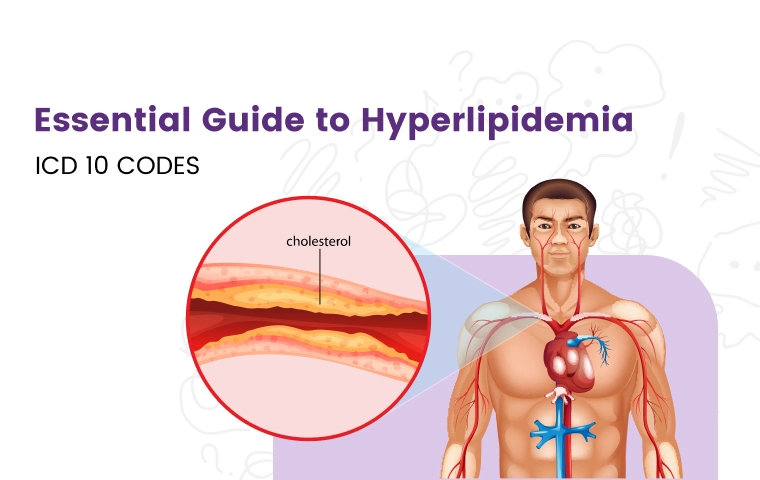Hyperlipidemia (High Blood cholesterol) is considered a major risk for people all over the globe. 94 million adults' cholesterol levels are higher than the normal reference range. As a healthcare specializing in cardiology, you may be familiar with the various health conditions related to high cholesterol.
You may encounter a patient with suspected hyperlipidemia, and it is important to document the diagnosis to ensure the best possible care accurately. In order to do so, you must use ICD 10 codes for hyperlipidemia during the documentation process.
But what exactly are ICD 10 codes for hyperlipidemia? And how can these codes help healthcare providers in delivering quality care?
In this article, we'll explore the ICD 10 codes for hyperlipidemia and provide an in-depth guide for providers and coders on how to ensure accurate diagnosis coding.
What is Hyperlipidemia?
Hyperlipidemia, also known as high cholesterol, is a medical condition characterized by abnormally high levels of lipids (fats) in the blood. These lipids include cholesterol and triglycerides.
Cholesterol is a type of lipid that is essential for various bodily functions, including cell membrane structure and hormone production. However, elevated levels of cholesterol in the blood can lead to the accumulation of fatty deposits in the arteries, which can increase the risk of cardiovascular diseases, such as heart attack and stroke.
Symptoms of Hyperlipidemia
Hyperlipidemia itself does not typically cause specific symptoms that are easily recognizable. It is often referred to as a "silent" condition because individuals with high cholesterol levels might not experience noticeable symptoms until they develop complications such as heart disease or stroke.
This is why regular cholesterol level screenings are important, especially for individuals with risk factors such as a family history of heart disease, obesity, diabetes, or a sedentary lifestyle.
Hyperlipidemia vs Dyslipidemia
Hyperlipidemia and Dyslipidemia are related terms that refer to conditions involving abnormal levels of lipids (fats) in the blood. However, they have slightly different meanings and implications:
Hyperlipidemia is a broader term that refers specifically to elevated levels of lipids, including both cholesterol and triglycerides, in the blood. In contrast, Dyslipidemia is a more general term that refers to any abnormal lipid levels in the blood, whether they are elevated or decreased. Providers are recommended to use E78.5 as dyslipidemia icd 10.

What is ICD 10 code for hyperlipidemia?
For correct documentation, providers should use accurate hyperlipidemia ICD 10 codes while documenting the diagnosis. it is advised to use icd 10 e78.5 to report hyperlipidemia unspecified.
Do I always need to report the E78.5 Diagnosis code for Hyperlipidemia?
As of now, you may have got an idea about what is hyperlipidemia icd 10 code, but it is important to note that E78.5 may not be the only ICD 10 code for hyperlipidemia. With every complexity of hyperlipidemia, the ICD 10 code changes.
Is Hyperlipidemia the same as high cholesterol?
Hyperlipidemia is known as high cholesterol by many people, but it is not exactly the same. High cholesterol and hyperlipidemia are related conditions, but they are technically different medical diagnoses.
High cholesterol refers to elevated levels of lipids within the bloodstream. Hyperlipidemia, on the other hand, is a blanket term for any condition that involves abnormally high levels of lipids in the blood. Diagnosis code e78.5 is used as icd 10 high cholesterol as well.
Types of Hyperlipidemia and Relevant ICD 10 Codes
Hyperlipidemia can be divided into further subcategories, and each one requires a specific ICD 10 code.
Pure Hypercholesterolemia:
This condition is characterized by abnormally high levels of cholesterol in the blood. The corresponding ICD 10 code for hypercholesterolemia is E78.00.
Familial Hypercholesterolemia:
Familial hypercholesterolemia is an inherited condition that is characterized by abnormally high levels of cholesterol in the blood due to a genetic mutation. The corresponding ICD 10 code for familial hypercholesterolemia is E78.01.
Pure Hyperglyceridemia:
This condition is characterized by abnormally high levels of triglycerides in the blood. The corresponding ICD 10 code for hyperglyceridemia is E78.1.
Mixed Hyperlipidemia:
Mixed hyperlipidemia describes a combination of elevated levels of both cholesterol and triglycerides in the bloodstream. The corresponding ICD 10 code for mixed hyperlipidemia is E78.2.
Hyperchylomicronemia
Hyperchylomicronemia is a rare condition characterized by extremely high levels of chylomicrons, a type of lipoprotein that carries dietary fats in the blood. This condition can lead to symptoms like abdominal pain and pancreatitis. E78.3 is used as Hyperchylomicronemia ICD 10 code.

How To Diagnose Hyperlipidemia
Diagnosing hyperlipidemia typically involves a blood test called a lipid panel or lipid profile. A lipid panel is a comprehensive test that measures various types of lipids (fats) in your blood, including cholesterol and triglycerides.
This test provides valuable information about your cardiovascular health and risk factors for heart disease. Providers need to use Z13. 220 as lipid panel icd 10 code.
Conclusion
Hyperlipidemia is a major risk factor for cardiovascular diseases. It is important to properly diagnose this condition in order to provide quality care and ensure accurate coding. ICD 10 codes for hyperlipidemia can help healthcare providers ensure that the diagnosis is accurately documented, allowing for reimbursement by insurance companies.
ABOUT AUTHOR

Bill Gunn
As a blog writer with years of experience in the healthcare industry, I have got what it takes to write well researched content that adds value for the audience. I am a curious individual by nature, driven by passion and I translate that into my writings. I aspire to be among the leading content writers in the world.
